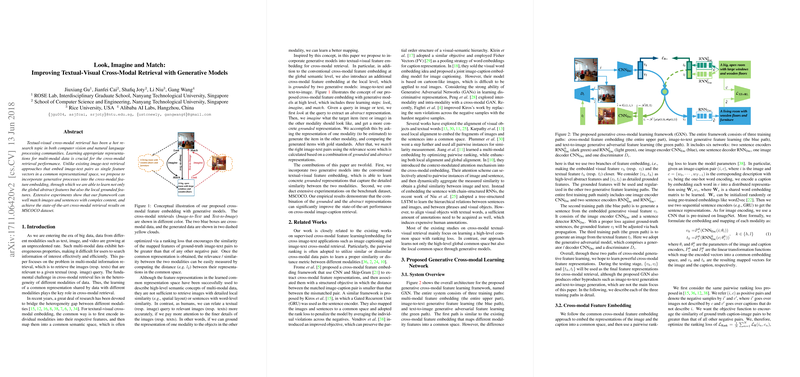Look, Imagine and Match: Improving Textual-Visual Cross-Modal Retrieval with Generative Models
The paper "Look, Imagine, and Match: Improving Textual-Visual Cross-Modal Retrieval with Generative Models" explores the application of generative models to enhance cross-modal retrieval tasks, notably between textual and visual data. This research investigates the embedding of text and images into a shared feature space where their semantic similarities can be effectively measured. This paper is authored by Jiuxiang Gu and colleagues, contributing to the domain of computer vision.
The central proposition of this paper lies in utilizing generative models to improve the retrieval accuracy in a multimodal context. Traditional cross-modal retrieval methods often rely on discriminative models, which may not fully capture the richness and underlying semantics of the visual-textual domain. By integrating generative approaches, this paper aims to construct a more representative shared embedding space.
Methodology
The paper introduces a novel framework that combines generative models with existing retrieval architectures. This framework operates by imagining or generating hypothetical representations that bridge the gap between the modalities, thus enhancing the matching process. It enhances the feature extraction process by not only looking at real-world samples but also imagining variations that may bridge semantically close instances across modalities. The aim of such a framework is to better align textual and visual content in the latent space, allowing for more effective retrieval.
Results and Evaluation
The authors report significant improvements in their benchmark results over conventional methods, demonstrating the efficacy of their proposed approach. Specific numerical results indicate noteworthy enhancements in retrieval metrics, including precision, recall, and overall retrieval accuracy. These improvements highlight the potential of generative models to innovate in the cross-modal retrieval space by offering a more nuanced understanding of the semantic correlation between text and visuals.
Implications and Future Work
The implications of this research are multifaceted. Practically, the integration of generative models in cross-modal retrieval can lead to advancements in various applications such as image tagging, visual search engines, and digital asset management. Theoretically, the approach encourages further exploration into how generative techniques can play a role in multimodal machine learning tasks.
Future work stemming from this research could delve into the scalability of this framework when applied to large-scale datasets. In addition, further refinement of the generative components could lead to more subtle and sophisticated understanding of cross-modal relationships. As generative models continue to evolve, driven by advances in models such as GANs and VAEs, their application in cross-modal retrieval offers a promising avenue for innovation in artificial intelligence.
